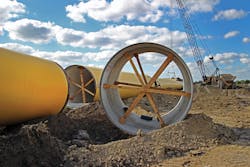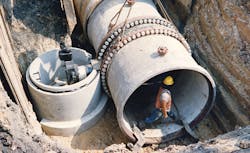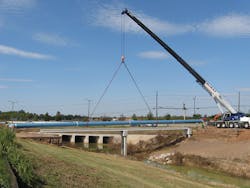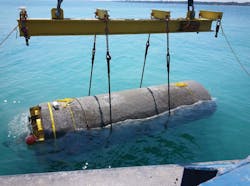Choosing the Right Pipe Material
Design and operational elements to consider today when determining the best fit for tomorrow
By Justin Reeves and Philip Wheat
For water and wastewater pipe experts, choosing the right pipe material can be a touchy subject. If we are honest with ourselves, we all have a favorite — something that has served us well or has helped us successfully solve a design, construction, or operational problem. It’s okay to have a favorite, but it’s not okay to consider your favorite a silver bullet for every situation or challenge, forsaking the benefits of other pipe materials. Such an approach discounts decades of studies, testing, material science, manufacturing, and construction advancements and innovations. It also does not serve our community and industry well.
The purpose of this article is not to survey the history of pipe materials or to review every product available today. Something of that magnitude warrants a series, if not a book, to do it justice. Rather, this article’s purpose is to summarize some benefits of various pipe materials common in the water and wastewater industry, to present design or operational scenarios that may cause one material to rise above others, and to challenge us all to remember that in the underground world, there is no one-size-(or-material)-fits-all solution.
Particularly in systems with low operating pressures, the design of large diameter flexible pipe, such as the
108-inch diameter cement mortar lined steel pipe shown here, can be governed not by ultimate loading scenarios but by the loads experienced during handling and construction. Photo courtesy of LAN.
Pipe Materials Available Today
The history of pipe manufacturing is fascinating. The impact of World War II on material availability, as well as the knowledge gained over time regarding the impacts of hydrogen sulfide gas on concrete, spawned new pipe products that we rely on today. As the old saying goes, “Necessity is the mother of invention.” Thus, after decades of study, development, testing and innovation, we now have a reliable pool of pipe materials for our water and wastewater projects.
Common pipe materials include: bar-wrapped concrete pressure, ductile iron, fiberglass, high-density polyethylene (HDPE), prestressed concrete cylinder, polyvinyl chloride (PVC), and steel pipe. From this pool, there are numerous variations of pipe classifications, coatings, linings, manufacturing differences, and so on. No one can know and fully understand all possibilities and thus it is no surprise that we develop a preference over time. But, the variations can be important and can benefit your project when properly considered — or become a liability when not. For example:
• Bar-wrapped concrete pressure pipe is designed as flexible pipe but does have some rigid characteristics that can provide great confidence to owners; however, quick field adaptability can be a challenge and condition assessment can be more difficult.
• Ductile iron pipe is adaptable, is designed as flexible pipe but has rigid characteristics, and has a long service history; however, metallurgy can be important when considering thrust implications, and cathodic protection maintenance can be challenging.
• Fiberglass pipe is resistant to corrosion, lightweight, and customizable for any application, but thrust restraint can require large blocking and proper embedment is critical to structural integrity.
Valves and pipe are both components of a single system, and they should be designed together based on the operational scenarios expected and the loading they will experience. Pipe material selection, design, and embedment requirements cannot overlook the impacts of in line valve material, design, and backfill. Photo courtesy of LAN.
• HDPE pipe is resistant to corrosion and is fully restrained; however, it is susceptible to temperature fluctuations and the inside to outside diameter relationship requires a little give and take.
• Prestressed concrete pressure pipe is a rigid pipe that can be used in almost unlimited site conditions and can simplify some installation, but failure can be catastrophic and design is quite complicated compared to other materials.
• PVC pipe, like HDPE and fiberglass, is resistant to corrosion and is also lightweight with a long service history; however, it is impacted negatively by ultraviolet light and can experience rapid crack propagation.
• Steel pipe provides long lay lengths, can be fully restrained, and is highly adaptable in the field, but construction loading must be considered, and proper embedment is critical to developing structural integrity.
Some projects may present opportunities to competitively bid multiple materials while others will show that only one material or variation is suitable for the job. There is a pipe for every project though, and the challenge is knowing how to sift through the variables, which include soil conditions, material availability, water chemistry, pipeline diameter, contractor ability, and many others. The following discussion highlights a few variables that we often encounter and consider during pipeline design. These variables fall into two categories: design and installation considerations; and operational considerations.
Design and Installation Considerations
A simple question to begin with is whether your pipeline will be installed by open cut or trenchless methods. Even this basic question has a potential impact on the pipe material ultimately proposed for installation. Open cut installation requires evaluation of construction loading scenarios and may require a much different emphasis on construction inspection. Alternatively, depending on the trenchless methods proposed, consideration should be given to laydown area available, how joints can or will be restrained (where needed), and various encasement options required.
For flexible pipe materials installed by open cut, embedment is the most important element of the installation. Flexible pipe, such as fiberglass or steel, interacts with the surrounding soils to gain its structural integrity. Either flexible pipe must be used in the right soils, or the trench (width, bedding/embedment material, filter fabric requirements, and so on) should be designed to compensate for less ideal soil conditions.
Accordingly, inspection is of great importance to ensure that the embedment material has the proper gradation, is installed in appropriate lifts, and is compacted or consolidated. If you are considering a project where full-time inspection cannot be provided, a more rigid product, if available, may provide a better long-term value.
Aerial crossings are often designed utilizing steel pipe due to requirements for the pipe to serve as a beam. Even in scenarios where an aerial crossing will be continuously supported across a span, construction may induce critical loading scenarios that factor into design. Photo courtesy of LAN.
When considering a pipeline with a casing (generally a tunnel installation but also some open cut), pipe dimensions and joint connections can impact the material selection. In a recent conceptual design for a 42-inch sanitary sewer force main, we initially considered all the products listed above. However, when looking at the casing size impacts, the field narrowed quickly due to the large quantity of trenchless work involved. Ductile iron, prestressed concrete, and PVC pipe all required larger diameter liner plate (up to 70 inches compared to 64 inches for bar-wrapped, fiberglass, HDPE, and steel pipe). Budget comparisons of this concept design showed a difference of $34 per linear foot for material prices alone when comparing a 64- to a 70-inch casing. When your project has a large volume of trenchless work, the pipe material can make a significant impact on your bottom line.
Other considerations for pipe design include thrust restraint, beam strength, and the presence of parallel or crossing utilities.
• Thrust Restraint: Ductile iron pipe can be restrained easily with appropriate design, but there are metallurgical differences in some fittings and restraints that can reduce safety factors if not properly considered. Prestressed and bar-wrapped pressure pipe must be designed with appropriate fittings, bell thicknesses, and cylinder thicknesses to properly transfer longitudinal forces. In some installations, thrust blocking may be the only mechanism for restraint of fiberglass pipe. For these reasons, in pressure system alignments with a high volume of bends and fittings, welded steel pipe may prove most reasonable due to the inherent restraint provided.
• Beam Strength: Beam strength can be easily overlooked in analyses but is foundational to some system designs. Aerial crossings of creeks require an evaluation of beam strength to withstand lateral hydraulic loading and buoyant forces, and to support the weight of both pipe and product between piers. Beam strength should also be considered where large diameter valves are installed and hung cantilevered from a pipe, even if only temporarily in construction. We’ve even seen beam strength come into play during construction with something as simple as how the contractor is laying out pipe in the field. If beam strength is not properly considered, the service life of your pipe can be impacted.
• Parallel or Crossing Utilities: For work in congested urban corridors, we often install pipelines knowing future work will cross or parallel the installation. Flexible pipe, which relies on the soil/material in the pipe zone for strength, is more susceptible to failure when excavating a parallel trench. Any metallic pipe can easily pick up stray current from crossing pipelines or even overhead high-voltage lines. An awareness of these factors can (and should) influence pipe material selection.
Fiberglass pipe provides great flexibility/adaptability for various design challenges. Pictured here is a bifurcated wye that includes a 78-inch mainline and two 54-inch diameter branches that were required in a sanitary sewer installation to cross a creek without exposing the pipe crown. Photo courtesy of LAN.
Operational Considerations
Selecting a pipe material only for design considerations, though, is short-sighted. Ultimately, we need to provide a product that meets the long-term needs of the owner, so operational considerations are also critical. There are many operational factors that may vary widely by geography. The following summarizes a few operational considerations that can directly impact material selection.
• Internal Corrosion: A small amount of hydrogen sulfide can have major impacts on corrosive materials, which is why our industry champions corrosion-resistant products in sanitary sewer applications. The final decision should be based on the life cycle cost and whether corrosion-resistant materials provide a constructible, long-term solution.
• Tuberculation: Ferrous oxide from iron oxidation, or tuberculation, can build up on the inside of a metallic pipe in wastewater applications. This again highlights the emphasis on plastic pipe products for sanitary sewer installations.
• Cathodic Protection: Buried metal will corrode if left to its own devices sooner or later. Knowing both the soil profile and the operational abilities or tendencies of an owner is critical when selecting pipe material. The maintenance involved with cathodic protection systems versus the material properties of a plastic pipe should be considered.
Every project is unique, and some projects should cause a design team to balance multiple and competing considerations. Something like subaqueous construction must consider trench conditions, construction loading, joint integrity and inspection capability. Photo courtesy of LAN.
• Field Repair: Often coatings are applied to some pipe materials to adjust for corrosion and tuberculation potential. Damage to the coating, however, can exacerbate the very conditions it is trying to protect against. Likewise, the failure mechanism of different materials emphasizes the importance of inspection during construction. Many failures from missed field repairs will not manifest until years after construction.
• Condition Assessment: In the underground world of pipe, understanding failure mechanisms and tracking ongoing conditions are always a challenge. Material selection and design should consider methods to review and track condition over time to avoid catastrophic failure and address unforeseen developments.
Conclusion
How many times in your life will you make a choice that others must live with for 50 years or more? There are likely very few circumstances that come to mind. However, this is exactly what we are doing when selecting a pipe material, and selecting the wrong material can have significant financial consequences. Pipe design should be executed with the long-game in mind. It starts with understanding the variables and choosing the material (or materials) accordingly, with consideration of both design and operational elements. One size does not fit all conditions, and our responsibility as engineers is to consider all conditions today to choose the best fit for tomorrow. WW
About the Authors: Justin C. Reeves, P.E., LEED AP, is a team leader and senior associate at Lockwood, Andrews & Newnam, Inc. (LAN), a national planning, engineering and program management firm. He can be reached at [email protected]. Philip B. Wheat, P.E., is a senior project manager at LAN. He can be reached at [email protected].





